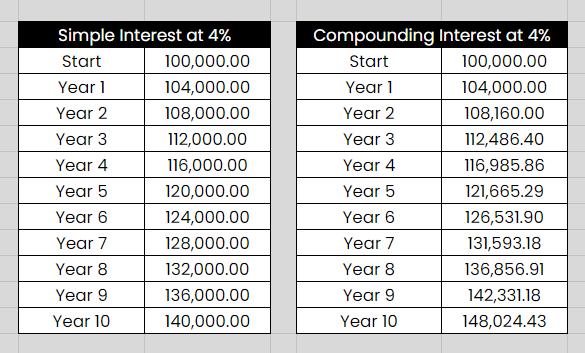Section 5-6: Compound Interest Tables
Section 5-6: Compound Interest Tables
Overview

 Compound interest tables are pre-calculated tables that provide the future value of an investment or loan for different combinations of principal amounts, interest rates, compounding periods, and time periods. These tables are useful for quickly determining the future value of an investment or loan without having to perform complex calculations manually. Here's how compound interest tables typically work:
Compound interest tables are pre-calculated tables that provide the future value of an investment or loan for different combinations of principal amounts, interest rates, compounding periods, and time periods. These tables are useful for quickly determining the future value of an investment or loan without having to perform complex calculations manually. Here's how compound interest tables typically work:
Principal Amounts: Compound interest tables usually list a range of principal amounts along the top row of the table. These amounts represent the initial investment or loan amount.
Interest Rates: The leftmost column of the table displays different interest rates, typically ranging from 1% to 20% or more. These rates represent the annual interest rate applied to the principal amount.
Compounding Periods: Compound interest tables may provide different tables or sections for different compounding periods, such as annually, semi-annually, quarterly, or monthly. Each table corresponds to a specific compounding frequency.
Time Periods: Compound interest tables often include a range of time periods, usually in years, along the side of the table. These time periods represent the duration for which the investment or loan is held.
Table Entries: The entries in the table represent the future value of the investment or loan for a given combination of principal amount, interest rate, compounding period, and time period. Each cell in the table provides the future value, including both the principal amount and the accumulated compound interest.
Interpolation: Compound interest tables may not cover every possible combination of principal amounts, interest rates, compounding periods, and time periods. In such cases, users can interpolate between the values provided in the table to estimate the future value for their specific scenario.
Compound interest tables are valuable tools for investors, lenders, and borrowers who want to quickly estimate the future value of their investments or loans based on different parameters. They are especially useful for making comparisons between different investment options or loan terms and for understanding the impact of compounding on the growth or cost of funds over time. However, it's essential to verify the accuracy of the values obtained from compound interest tables and to consider other factors, such as fees, taxes, and inflation, when making financial decisions.
Videos (Click on Image to View Videos)
Online Textbook Read Section 5-6: (Compound Interest Tables)
